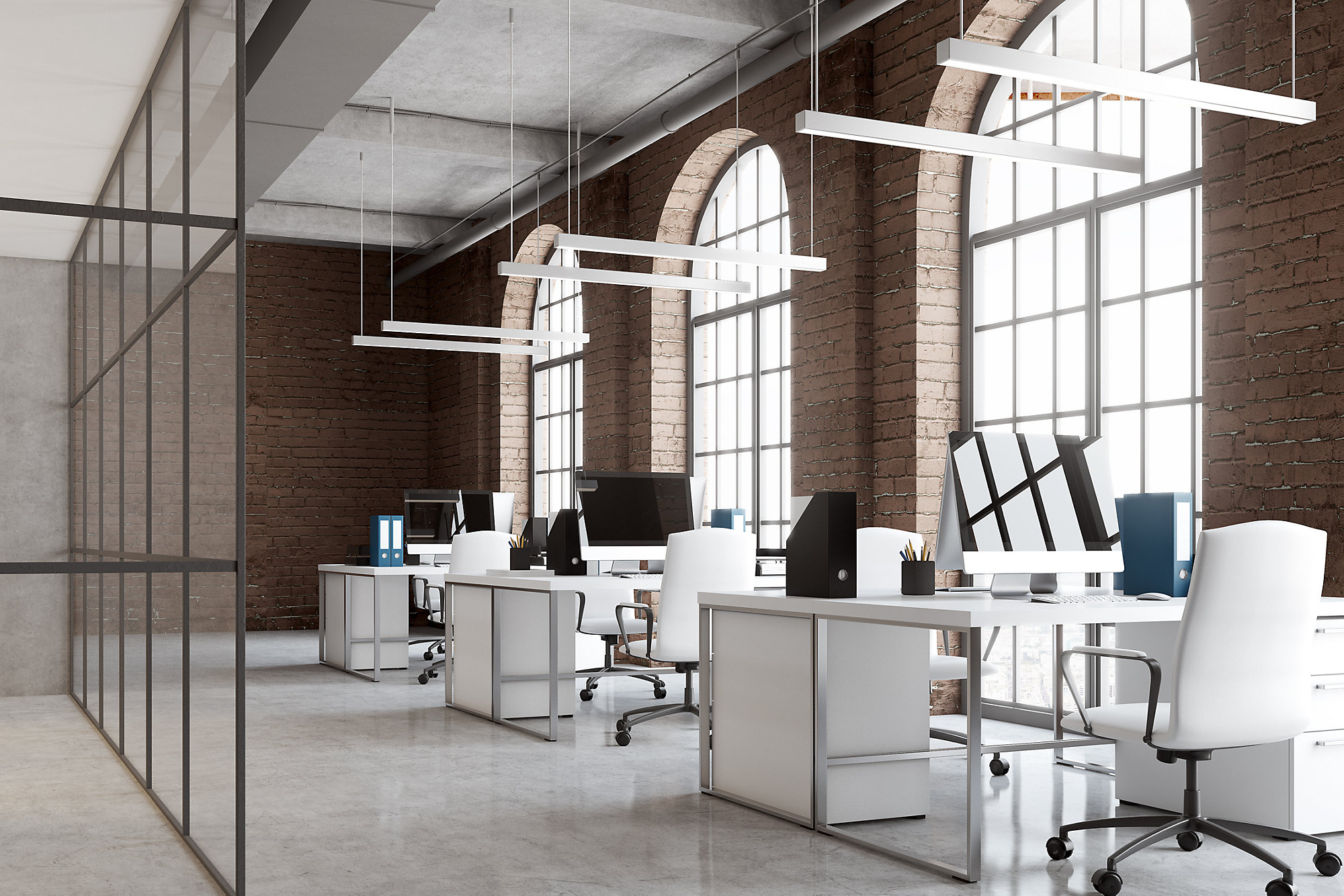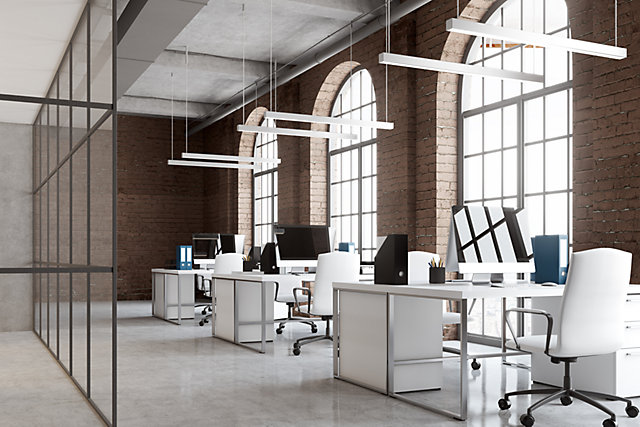
Increase productivity with the right light
Optimum lighting at the workplace
We're familiar with it due to our own experience: on a gloomy autumn morning, making our way to work is sometimes difficult. Light is important for our body clock, and is necessary for the production of hormones such as melatonin and serotonin.
These, in turn, have an enormous impact on our performance. When there's light to stimulate the production of feel-good hormones, the brain ensures our cells are functioning at peak performance. Our mental and physical fitness increase – giving our productivity a much-needed boost.
However, people's ability to perform has its limits and varies over the course of a day. And yet when we have the right light at the right time, we can control our circadian rhythms and thereby optimise our productivity. If you think about your workplace now, it is easy to imagine the positive impact that perfect illumination can have on personal performance.
The LED has made even more sophisticated lighting concepts possible
People who work in enclosed spaces in offices rarely get to enjoy natural daylight. Office designers and ergonomics experts have therefore been working on the the right light for the world of work since the seventies. In the past, a simple rule of thumb applied: switch on the light when it's too dark. However, the conventional light bulb was often unable to do the job, a situation that only changed with the introduction of LED bulbs in the late 2000s.
Since then, lighting concepts for the workplace have improved significantly.
Flexibility as a factor
The potential uses for LED bulbs for optimal illumination of the workplace are virtually unlimited: They are compact, robust, easy to install and are available in almost any shape.
Light quality as a factor
Even if a bluish light and the long time they needed to start up initially dampened enthusiasm for LEDs, the quality of light that they provide today is significantly better than any other light source. The light efficiency is good, the light intensity leaves nothing to be desired, and the light emitted by LEDs is now neither cold nor unpleasant.
Sustainability as a factor
Incidentally, LED lamps also demonstrate brilliance with their extremely economical levels of energy consumption, low heat generation and a record-breaking service life when compared to other light sources.
While poor light can compromise productivity, and too little light can even cause illnesses, today's lighting systems based on LEDs create lighting conditions at the workplace that closely resemble the natural light spectrum of the sun.
kaiserkraft can provide professional LED lighting solutions for every area of use. Adequate lighting creates the conditions you need for a better performance and higher levels of motivation. Discover light made to measure now.
LED lighting allows ergonomic lighting conditions to be created that have a positive effect on your employees’ ability to concentrate, levels of satisfaction, and productivity.
But what does optimal lighting at the workplace look like?
The law specifies how bright the workplace should be
The basic requirements for lighting conditions at the workplace are governed by the Occupational Health and Safety Act. According to the Workplace Ordinance, rooms used for work should have a daylight quota of at least 2 percent, and offer a line of vision to outdoors – unless the structural conditions at work sites such as railway stations or airports do not permit this.
Transparent surfaces such as windows and skylights must account for at least 10 percent of the floor area, and this figure increases to at least 20 percent for activities involving “difficult visual tasks”. Doors and walls also count if they are glazed.
These are the general legal requirements that apply to lighting conditions at the workplace. Whether your employees perceive the lighting as good or bad, however, depends on the type of activities they are carrying out.
Lighting experts are also unanimous in this regard, and therefore recommend lux guidelines that are tailored to the individual working environment.

Computer workstations
The most widespread type of workstation today is the computer workstation. The brightness should total 500 – 750 lux, and ideally consist of a combination of natural daylight and artificial light, as well as direct and indirect light.
Assembly activities
The same illuminance applies to workplaces in assembly, where employees carry out precision work on smaller items of equipment and machine tools.
With visual aids
Employees who need visual aids or suffer from age-related impairments generally require more brightness. The recommended luminosity at a normal workplace should total 750 – 1500 lux for these employees.
Intricate jobs
For more complex tasks such as technical drawing or working on intricate components, which require a great deal of concentration, experts recommend an illuminance totalling 1000 – 2000 lux.
Logistical tasks
For logistical tasks, such as packing and shipping goods, or simple assembly work such as drilling and milling, a luminosity of 200 – 300 lux is ideal. For activities in warehouses, 50 – 200 lux is sufficient.
We have collected more information on optimum workplace lighting for you in our comprehensive purchasing guide.
Five steps to perfect lighting at the workplace
The range of potential designs is enormous, and extends from easy-to-implement tips for everyday situations to complex lighting concepts. Companies that would like to go one step further than the Occupational Health and Safety Act specifies can now choose from a large number of different high-tech lighting systems.
“Today's systems work with sensors that not only detect the presence of employees, but also the amount of daylight, and automatically dim themselves accordingly”, as lighting expert Jürgen Waldorf explains.

So how should you proceed when designing your lighting concept?
- From above
Like daylight, the light must come from above. This not only makes it seem like natural light, but also increases the ability of your employees to concentrate. - Correct colour
The colour temperature, which is specified in Kelvin, plays a decisive role. The midday sun reaches a colour temperature between 5,500 and 5,800 Kelvin, and people are particularly productive in this level of light. - Be careful
A top performance can't be maintained indefinitely. That's why your employees should be able to adjust the light themselves – for example, to dim it during breaks. - The right combination
Use artificial and natural light to avoid glare. Arrange workplaces at right angles to windows, and use blinds. - Direct and indirect
Try and obtain a combination of direct and indirect light. Dimmable desk lamps are the best way to supplement an overhead light.
One of the leaders in innovation when it comes to state-of-the-art lighting concepts are the lighting engineers from Waldmann. The medium-sized company from Villingen-Schwenningen is a specialist for lighting solutions for industry, offices, care services and health care. Visit our special Waldmann shop!
“Human-centric lightning” is biodynamic light
Lighting that is designed to suit people's circadian rhythms increases your personal performance – after all, those who feel at ease also work more productively. Lamps that can be controlled using a smartphone app are no rarity these days. “Human-centric lighting” is the term used for lighting concepts that create optimum working conditions with exactly the right amount of light.
Anyone who needs to give their circulation a little boost in the early morning should not only take a cold shower and drink a hot coffee, but also place their trust in these new options for digitally controlled lighting. Bright light may not sound particularly cosy, but it has a naturally stimulating effect on your own circadian rhythm. Just a few clicks are all that are needed to automatically preset the lighting levels throughout the day – including the warm atmosphere that a sunset creates at the end of the day.
Experts such as the Feng Shui consultant Günther Sator, and Hans-Jürgen Hentschel, an author and specialist for psychosomatic medicine, who have been studying the influence of light on human performance for decades, expect these measures to increase productivity by up to 20 percent.
In light of all this potential, which company can still afford not to invest in optimal lighting at the workplace?


